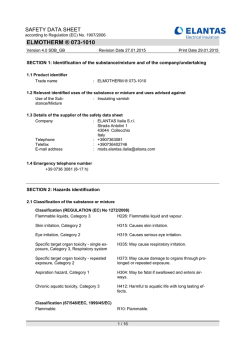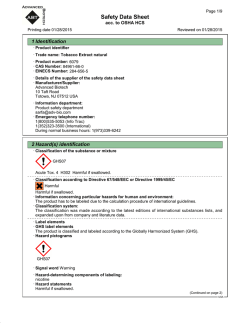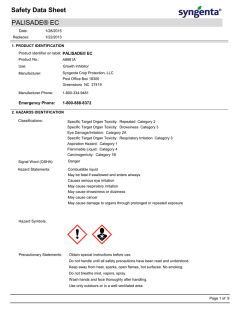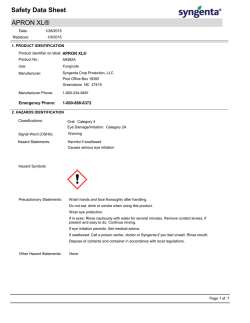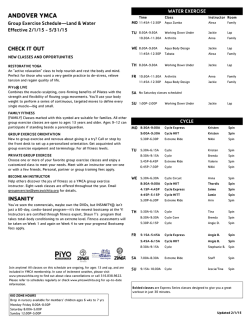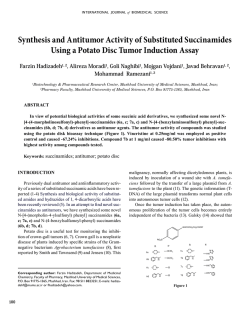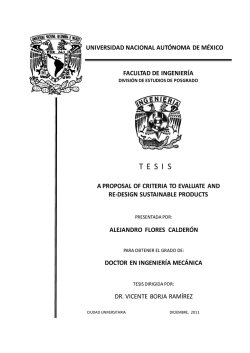
Spin labeled antioxidants protect bacteria against
Toxicology Letters 144 (2003) 289 /294 www.elsevier.com/locate/toxlet Spin labeled antioxidants protect bacteria against the toxicity of alkylating antitumor drug CCNU Vesselina Gadjeva a,*, Grozdanka Lazarova b, Antoaneta Zheleva a a Department of Chemistry and Biochemistry, Medical Faculty, Thracian University, 11 Armeiska Str., 6000 Stara Zagora, Bulgaria b Department of Microbiology, Medical Faculty, 11 Armeiska Str., Thracian University, 6000 Stara Zagora, Bulgaria Received 11 December 2002; received in revised form 5 May 2003; accepted 5 May 2003 Abstract We have studied the toxic effect of the alkylating antitumor drug N ?-cyclohexyl-N -(2-chloroethyl)-N -nitrosourea (lomustine, CCNU) on Escherichia coli (E. coli ) and Staphylococcus aureus (S. aureus ) strains, alone and in presence of oxygen radical-scavenging substances [Vitamin E, stable nitroxyl radical 2,2,6,6-tetramethylpiperidine-N -oxyl (TMPO), and spin labeled (nitroxyl free radical moiety containing) analogues of CCNU] and compared with that of the alkylating antitumor drug 5-(3,3-dimethyltriazene-1-yl)-imidazole-4-carboxamide (dacarbazine, DTIC). All spin labeled compounds tested were almost no toxic at doses of 50 /500 mM/ml, whereas the alkylating antitumor drug CCNU showed toxicity in a dose dependent manner. Even low doses of spin labeled nitrosoureas provided protection against the toxicity caused by the antitumor drug CCNU alone. The lowest toxicity against E. coli and S. aureus were achieved when 500 mM/ml of CCNU was combined with 200 mM/ml of spin labeled nitrosourea N -[N? -(2-chloroethyl)N ?-nitrosocarbamoyl]-glycine amid of 2,2,6,6-tetramethyl-4-aminopiperidine-1-oxyl (SLCNUgly). A combination of TMPO with vitamin E completely abolished the toxicity of CCNU. Endogenous formation of oxygen radicals and their possible involvement in CCNU toxicity towards the bacteria strains tested have been also discussed. # 2003 Elsevier Ireland Ltd. All rights reserved. Keywords: CCNU; DTIC; Spin labeled; Antioxidants; E. coli ; S. aureus 1. Introduction 2-Chloroethylnitrosoureas and triazenes are alkylating chemotherapeutic agents. Some of them, such as N ?-cyclohexyl-N -(2-chloroethyl)-N -nitrosourea (CCNU) and 5-(3,3-dimethyltriazene-1-yl)imidazole-4-carboxamide (DTIC) are used for * Corresponding author. Tel.: /359-42-600-879; fax: /35942-600-005. E-mail address: [email protected] (V. Gadjeva). treatment of human cancers, mainly lymphomas, gliomas, a few solid tumors and melanomas (Comis, 1976; Carter et al., 1988). Unfortunately, the clinical efficacy of these drugs is limited because they show delayed and cumulative hematological toxicity (Gnewuch and Sosnovsky, 1997). Reduced toxicity and increased antineoplastic properties were achieved when nitroxyl (aminoxyl) groups, such as 2,2,6,6-tetramethylpiperidine-N oxyl (TMPO) were introduced into the chemical structure of certain antitumor drugs (Sosnovsky, 0378-4274/03/$ - see front matter # 2003 Elsevier Ireland Ltd. All rights reserved. doi:10.1016/S0378-4274(03)00234-0 290 V. Gadjeva et al. / Toxicology Letters 144 (2003) 289 /294 1992; Gnewuch and Sosnovsky, 1997). This finding encouraged us to synthesize a number of spin labeled analogues of the anticancer drugs CCNU and DTIC. These compounds showed advantages over CCNU and DTIC, having lower toxicity and higher anticancer activity against some experimental tumor models (Raikov et al., 1993; Zheleva et al., 1995, 1996b). Using electron spin resonance (ESR) we have shown that spin labeled nitrosoureas, spin labeled triazenes and their precursor 2,2,6,6-tetramethyl-4-aminopiperidine-1-oxyl (4amino TMPO) can scavenge superoxide anion (+ O2) and exhibit high superoxide scavenging activity (SSA) (Gadjeva et al., 1994). Moreover, we have demonstrated a light dependent nitric oxide (+ NO) generation from the antitumor drug CCNU (Zheleva et al., 1997). Recently, because of these facts we have made an assumption that a probable in vivo generation of the highly toxic ONOO and + OH by CCNU might contribute to its severe toxicity, while the lower toxicities of spin labeled analogues of CCNU are possibly due to their excellent SSA (Zheleva and Gadjeva, 2001). Great problems for all clinically used nitrosoureas are adverse reactions on the gastrointestinal tract such as diarrhea and mucositis (Mc Clay and Mc Clay, 1996). Bearing in mind these adverse effects of nitrosourea drugs and also to try to explain the possible mechanism of nitrosourea bacterial toxicity we studied in vitro the influence of the antitumor drug CCNU on survival of Escherichia coli (E. coli ) and Staphylococcus aureus (S. aureus ) alone and in presence of oxygen radicalscavenging substances. (SLCNUgly) and 1-ethyl-1-nitroso-3-[4-(2,2,6,6tetramethylpiperidine-1-oxyl)]-urea (SLENU), spin labeled triazene 2,2,6,6-tetramethyl-4-[3-(4chloro-2-methylphenyl)-1-methyl-2-tiazenyl]-piperidyl-1-oxyl (SLTA) and nonlabeled glycine nitrosourea N -[N ?-(2-chloroethyl)-N ?-nitrosocarbamoyl]-glycine amid of cyclohexylamine (ChCNUgly) used for this study were synthesized as previously described (Raikov et al., 1993; Zheleva et al., 1995, 1996a). The chemical structures of the compounds used in this study are shown in Fig. 1. 2.2. Bacterial strains The bacterial strains used in this study included both a Gram negative bacterium (E. coli ATTC 25922) and Gram positive bacterium (S. aureus ATTC 53l54), purchased from Becton Dickinson Microbiology Systems, Cockeysville, USA. 2. Materials and methods 2.1. Compounds tested The antitumor drugs CCNU (Lomustine) and DTIC (Dacarbazine) were purchased from BristolMyers Squibb Co. (Wallingford, CT, USA). The free stable nitroxyl radical TMPO was purchased from Aldrich Chemical Co. (Milwaukee, USA). The spin labeled nitrosoureas N -[N?-(2-chloroethyl)-N ?-nitrosocarbamoyl]-glycine amid of 2,2,6,6-tetramethyl-4-aminopiperidine-1-oxyl Fig. 1. Chemical structures of the antitumor drugs CCNU (Lomustine), DTIC (Dacarbazine), nonlabeled ChCNUgly nitrosourea and spin labeled antioxidants used in this study. V. Gadjeva et al. / Toxicology Letters 144 (2003) 289 /294 291 2.3. Microbiological assay Fresh overnight cultures of either E. coli or S. aureus were diluted in normal saline to obtain a bacterial suspension of 5/105 colony-forming units CFU/ml. Bacterial suspensions at a final concentration 50 CFU/ml were exposed to the test compounds (50 /500 mM/ml) in phosphate buffered saline (PBS), pH 7.4, incubated 2 h at 37 8C and then spread on agar. The plates were incubated overnight at 37 8C and cell survival was calculated as %CFU versus control. 2.4. Statistical analysis The results are reported as mean9/S.D. Statistical analysis was performed with Student’s t-test and multiple regression analysis. P B/0.05 was considered statistically significant. 3. Results Effects of the three nonlabeled compounds (do not contain a nitroxyl radical moiety), CCNU, DTIC and nonlabeled glycine chloroethylnitrosourea (ChCNUgly) on survival of E. coli and S. aureus strains were compared with those of spinlabeled chloroethyl nitrosourea (SLCNUgly), spin labeled ethyl nitrosourea (SLENU), spin labeled triazene (SLTA) and also to that of the free stable nitroxyl radical TMPO (Fig. 2A, B). As is seen, the nitroxyl radical TMPO and all studied spin labeled compounds were almost no toxic for E. coli and S. aureus at doses of 50 /500 mM/ml whereas CCNU, DTIC and ChCNUgly showed toxicity in a dose dependent manner. The cell survival of E. coli and S. aureus after CCNU or DTIC treatment at different doses alone and in combination with SLCNUgly is presented in Table 1. The highest percent of survival for E. coli was achieved when 500 mM/ml of CCNU was combined with 200 mM/ml of SLCNUgly. At this combination CCNU toxicity effect was significantly counteracted (mean 88.0 vs. 35.3%, P B/ 0.001, t-test) and reached levels close to those of SLCNUgly administrated alone (mean 88.0 vs. 99.3%, P /0.05, t-test) (see Table 1). It is also Fig. 2. Cell survival of E. coli ATCC 25 922 and S. aureus after treatment with antitumor drugs CCNU and DTIC, spin labeled nitrosoureas SLENU, SLCNUgly and spin labeled triazene SLTA. Values represent the mean of three experiments. The S.E.M. associated with the data of this figure are within 6% of the presented values. evident, that for both bacteria strains there was almost no effect when SLCNUgly was added to DTIC (see Table 1). Comparisons between cell survival of E. coli after treatment with CCNU (500 mM/ml) alone and in combination with spin labeled antioxidants and the well known antioxidant vitamin E (200 mM/ml) are shown in Table 2. Cell survival for E. coli was not increased when CCNU was combined with nonlabeled chloroethyl nitrosourea ChCNUgly (mean 38.5 vs. 35.3%, P /0.05, t test). However, when bacteria were exposed to CCNU in combination with spin labeled ethyl nitrosourea SLENU (200 mM/ml) there was protection against the toxicity of CCNU and survival was almost the same as that of the bacteria coincubated with CCNU plus spin labeled chloroethyl nitrosourea SLCNUgly (mean 90.0 vs. 88.0%, respectively, P /0.05, t -test). It should V. Gadjeva et al. / Toxicology Letters 144 (2003) 289 /294 292 Table 1 Effect of SLCNUgly on the bacterial cell survival in the presence of CCNU and DTIC Cytostatic (mM/ml) Cell survival (% CFU) cytostatic P l/ Cell survival (% CFU) cytostatic/SLCNU gly (200 mM/ml) E. coli PBS (n/8) CCNU 50.0 CCNU 100.0 CCNU 500.0 DTIC 50.0 DTIC 100.0 DTIC 500.0 100 75.79/19.1 65.09/15.0 35.39/14.2 79.79/19.5 35.29/13.4 20.19/15.0 /0.05 99.39/3.1 /0.05 /0.05 36.79/15.1 23.79/7.0 S. aureus PBS (n/8) CCNU 50.0 CCNU 100.0 CCNU 500.0 DTIC 50.0 DTIC 100.0 DTIC 500.0 100 75.79/19.1 50.09/20.0 35.39/24.2 85.29/20.4 55.29/20.4 50.19/15.0 /0.05 100.39/9.1 B/0.01 B/0.01 65.49/5.8 69.39/11.2 /0.05 /0.05 56.79/9.1 53.79/7.0 B/0.001 86.49/5.8 (*P /0.05) B/0.001 88.09/19.2 (*P /0.05) Cell growth (% CFU from the control); n , number of the experiments; *P (in comparison with the effect of SLCNUgly administrated alone). also be mentioned that addition of TMPO plus vitamin E to CCNU provided better protection against CCNU bacterial toxicity than they did individually. Moreover, this combination completely abolished the toxic effect of CCNU (mean 99.8% (result is not presented) vs. 80.1 and 70.2%). As is seen SLTA, spin labeled analogue of DTIC decreases CCNU bacterial toxicity in a consider- able degree (mean 78.19/9.0, see Table 2), while there is no effect on DTIC bacterial toxicity (result is not presented). Interestingly, a definitive positive correlation existed between SSA (previously reported, Gadjeva et al., 1994) of the antioxidants used in this study and cell survival of E. coli after treatment with CCNU in combinations with the same antioxidants (R /0.805, P /0.029, Correlation analysis). Table 2 Effect of spin labeled antioxidants and vitamin E on the bacterial cell survival of E. coli in the presence of CCNU Compound a SSA activity ks (/105 M/s) b Cell survival (%CFU) CCNU/antioxidant CCNU (alone) ChCNUgly SLENU SLCNUgly SLTA TMPO Vitamin E 0 35.39/14.2 0 3.1 4.0 2.7 5.0 0.16 38.59/12.2 90.09/14.7 88.09/19.2 78.19/9.0 80.19/10.9 70.29/9.8 a Note comments on its evaluation made in Gadjeva et al. (1994). b Cell growth of E. coli ATCC 25 922 after treating with CCNU (500 mM/ml) alone and in combinations with antioxidants (200 mM/ml). 4. Discussion Toxicity mediated by reactive drugs may often occur through one or both of two main mechanisms. These are: (1) production of activated drug metabolites and (2) production of reactive oxygen species (ROS), often involving redox cycling. It is known that chloroethyl nitrosourea derivatives and DTIC exhibit in vivo activity by alkylation of nucleic acids and proteins (Wheeler et al., 1974; Babson and Reed, 1978; Lucas and Huang, 1982). Our present results clearly demonstrated that, both CCNU and DTIC were toxic to the bacterial models tested in a dose dependent manner. Be- V. Gadjeva et al. / Toxicology Letters 144 (2003) 289 /294 cause both of these drugs are alkylating agents, one might suppose alkylation is involved in the mechanism of the drug toxicity towards the both bacteria strains. However, in the present instance, we find that the bactericidal effects of CCNU were counteracted to a considerable degree by the spin labeled nitrosoureas and triazenes, while there was almost no effect when these compounds were added to DTIC. It is obvious that CCNU and DTIC exhibit their toxicity to the bacteria by different ways. Our present findings show that the main event involved in CCNU toxicity is probably due to the generation of ROS. This conclusion is based on the following: (1) the different behavior of both nitrosoureas SLCNUgly and its nonlabeled analogue ChCNUgly; (2) the effect of SLENU (without alkylating activity) on the survival of the bacterial models; (3) the different behavior of spin labeled triazene SLTA after its addition to CCNU or DTIC and (4) the influence of the three nitrosoureas on CCNU toxicity. SLCNUgly and SLENU possess excellent SSA while ChCNUgly has no SSA activity (see Table 2). Under our experimental conditions, SLCNUgly and SLENU counteracted the toxicity of CCNU to a considerable degree, while ChCNUgly alone (possesses no nitroxide) exhibited almost the same toxicity as CCNU and did not affect the toxicity after incubation with CCNU. Another indirect proof for involvement of ROS in CCNU toxicity was the complete prevention of that toxicity by adding of two typical antioxidants */TMPO and vitamin E (both possessing high SSA). Possible involvement of ROS in CCNU toxicity under our experimental conditions is supported also by several other studies. Acikgoz et al. (1995) demonstrated enhanced membrane lipid peroxidation caused by the antitumor drug CCNU. It is well known that increased production of lipid peroxides might due to increased levels of ROS (Esterbauer et al., 1992; de Zwart et al., 1999). On the basis of our formerly reported light dependent + NO generation from CCNU, we have proposed that the in vivo formation of ONOO and + OH contribute to the severe toxicity of this drug (Zheleva and Gadjeva, 2001). It seems very likely, during the incubation of the bacteria strains with 293 CCNU, the formation of these species is involved in the drug toxicity. Based on ESR studies, we have established that clinically used nitrosourea drug CCNU and triazene DTIC could not scavenge.O2 while their spin-labeled nitrosourea and triazene derivatives and their precursor 4amino-TMPO, could successfully scavenge.O2, exhibiting high SSA. Well-expressed SSA of the spin-labeled compounds was attributed to the presence of nitroxide in their structures. We also showed that the mechanism of SSA activity was a result of a redox cycling between nitroxide and its corresponding hydroxylamine according to the following equations (Gadjeva et al., 1994): Kr NO+ + O 2 H 0 NOH K0 + NOH + O 2 H 0 NO H2 O2 Based on the above mentioned equations and our formerly demonstrated light dependent + NO generation from antitumor drug CCNU we try to explain the nontoxic effect of the spin labeled nitrosoureas and prevention of the toxicity towards the bacteria by adding the latter compounds to CCNU under our experimental conditions by the following hypothesis: Since all nitrosoureas possess nitroso groups in their structures during their incubation with the bacteria strains they could generate + NO. This latter might react with.O2 to form ONOO and + OH by the following reactions (Freeman, 1994): However, during alone or together incubation of spin labeled nitrosoureas with CCNU and bacteria, the nitroxyl free radical moiety (+ N / O+ ) incorporated only in the spin labeled compounds might successfully compete with + NO (generated by any of the nitrosourea) for scaven- 294 V. Gadjeva et al. / Toxicology Letters 144 (2003) 289 /294 ging of + O2 and that could prevent formation of high toxic ONOO and + OH species. Having in mind that spin labeled 2-chloroethylnitrosoureas exhibited in vivo high antitumor effects against different tumor models and possessed antioxidant properties like those of the typical antioxidants as Vitamin E and TMPO, we consider that new combination chemotherapy schemes containing lower dose of the high toxic CCNU plus proper spin labeled nitrosoureas such as SLCNUgly may decrease the adverse effects of CCNU on the gastrointestinal tract probably by scavenging + O2. Further detailed analyses are in progress to clarify whether spin labeled nitrosoureas might counteract hemotoxicity of this class antitumor drugs. References Acikgoz, S., Bingol, F., Offin, S., Acikgoz, B., 1995. The effect of topical CCNU 1-(2-chloroethyl-3-cyclohexyl-1-nitrosourea) treatment on lipid peroxidation of glial tumors transplanted on rat brain. Gen. Pharmacol. 26 (2), 437 /439. Babson, J.R., Reed, D.J., 1978. Inactivation of glutathione reductase by 2-chloroethyl nitrosourea-derived isocyanates. Biochem. Biophys. Res. Commun. 83 (2), 754 /762. Carter, S.K., Schabel, F.M., Jr, Broder, L.E., Johnston, T.P., 1988. 1,3-bis(2-chloroethyl)-1-nitrosourea (BCNU) and other nitrosoureas in cancer treatment. A review. Adv. Cancer Res. 16, 273 /332. Comis, R.L., 1976. DTIC (NSC-45388) in malignant melanoma: a perspective. Cancer Treat. Rev. 60, 165 /176. de Zwart, L.L., Meerman, J.H.N., Commandeur, J.N.M., Vermeulen, N.P.E., 1999. Biomarkers of free radical damage. Applications in experimental animals and in human. Free Radic. Biol. Med. 26, 202 /226. Esterbauer, H., Gebicki, J., Puhl, H., Jugens, G., 1992. The role of lipid peroxidation and antioxidants in oxidative modification of LDL. Free Radic. Biol. Med. 13, 341 /390. Freeman, B., 1994. Free radical chemistry of nitric oxide. Chest 105, 79S /84S. Gadjeva, V., Ichimory, K., Nakazawa, H., Raikov, Z., 1994. Superoxide scavenging activity of spin labeled nitrosourea and triazene derivatives. Free Radic. Res. 21 (3), 177 /186. Gnewuch, C.T., Sosnovsky, G., 1997. A critical appraisal of the evolution of N -nitrosoureas as anticancer drugs. Chem. Rev. 97, 829 /1013. Lucas, V.S., Jr, Huang, A.T., 1982. Chemotherapy of melanoma. In: Siegler, H.F. (Ed.), Development in Oncology, vol. 5. Martinus Nijhoff, The Hague, p. 382 (Chapter 13). Mc Clay, E.F., Mc Clay, M.T., 1996. Systemic chemotherapy for the treatment of metastatic melanoma. Semin. Oncol. 23 (6), 744 /753. Raikov, Z., Gadjeva, V., Koch, M., Kolar, G., 1993. Synthesis of spin-labeled triazenes. Org. Prep. Procedure Int. 25, 473 / 477. Sosnovsky, G., 1992. A critical evolution of the present status of toxicity of aminoxyl radicals. J. Pharm. Sci. 81, 496 /499. Wheeler, G.P., Bowdon, B.J., Grimsley, J.A., Lloyd, H.H., 1974. Interrelationship of some chemical, physicochemical, and biological activity of several 1-(2-haloethyl)-1-nitrosoureas. Cancer Res. 34, 194 /200. Zheleva, A., Gadjeva, V., 2001. Spin labeled nitrosoureas and triazenes and their nonlabeled clinically used analogues */a comparative study on their physicochemical properties and antimelanomic effects. Int. J. Pharm. 212 (2), 257 /266. Zheleva, A., Raikov, Z., Ilarionova, M., Todorov, D., 1995. Spin labeled amino acid nitrosourea derivatives */synthesis and antitumor activity. Pharmazie 50, 25 /26. Zheleva, A., Carpenter, B., Ilarionova, M., Raikov, Z., 1996a. Synhtesis and in vivo evaluation of several new nitrosoureas as potential antimelanomic drugs. Br. J. Cancer 73 (Suppl. XXVI), 69. Zheleva, A., Raikov, Z., Ilarionova, M., Carpenter, B., Todorov, D., Armstrong, N., 1996b. Potential antimelanomic drugs 1. Synthesis and antimelanomic effect of a spin labeled DL-amino acid containing a 2-chloroethylnitrosocarbamoyl group. Pharmazie 51, 602 /604. Zheleva, A., Carpenter, B., Raikov, Z., Rowlands, C., Manusakis, V., 1997. Light dependent nitric oxide generation from antitumor drug CCNU. Int. J. Oncol. 11 (Suppl.), 917.
© Copyright 2025
